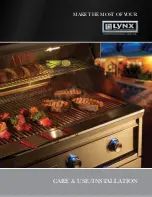
CARE & USE/INSTALLATION
|
26
27
|
CARE & USE/INSTALLATION
Extremely cold temperatures may cause your Trident ™ burners to light
inside
the
burners instead of
outside
. Once lit, if you hear a ‘whooshing’ sound, immediately turn
the burner knobs off to extinguish the flame and then immediately re-light the burners.
COLD WEATHER WARNING: PROPANE
MANUAL LIGHTING
If a burner doesn’t light after several attempts, it can be
match lit using the lighting rod stored in the drip tray.
First, make sure you’ve returned all of the control knobs
to the OFF position and have allowed 5 minutes for any
accumulated gas to dissipate before attempting to match
light a burner.
To match-light this burner, use the lighting rod to insert a lit
match through the cooking grate into the front slot of the
briquette tray for that burner.
Push and turn the corresponding burner control knob to
“LITE”. If the burner doesn’t light within 5 seconds turn the
knob off and wait 5 minutes before attempting to light it
again.
Trident ™ Burner
To match-light this burner, use the lighting rod to insert a lit
match through the cooking grate and through the
protective screen.
Push and turn the corresponding burner control knob to
“LITE”. If the burner doesn’t light within 5 seconds turn the
knob off and wait 5 minutes before attempting to light it
again.
LIGHTING YOUR GRILL
...
continued
PRE-HEATING
Pre-heating your grill every time you use it is extremely
important. Pre-heating allows the briquettes to properly
heat up, providing more even and more consistent cooking
results.
Pre-heat your grill by igniting all main burners, including the
Trident ™ burner, and setting them to “HI”.
Then close the hood and allow the grill to heat for 10
to 15 minutes, the hood thermometer should reach
approximately 450°. Once you’ve reached your de-
sired pre-heat temperature, turn off the burners that you
won’t be using to cook your food. Remember, surface
temperature can be up to 200° higher.
TYPES OF COOKING
The main ceramic burners and the Trident ™ burner in your
Lynx grill are capable of creating a range of heat intensities.
By varying the heat output, the number of burners used
and the position of the hood, you can create either direct
or indirect heat or a combination of both and develop a
wide variety of succulent recipes. There are two basic types
of grilling in an outdoor grill...
Direct Heat and Indirect Heat
Direct Heat
Direct heat cooking occurs when foods are placed
directly over the heat source. This form of heat is known as
“radiant” heat because the heat radiates directly from the
source to the food.
Direct heat is a must when you want to sear the outside of
your food to seal in flavor. Lynx Trident ™ Burners provide
the heat necessary to sear foods and seal in flavor.
Indirect Heat
Indirect heat cooking occurs when the food is not
close to the heat source. Heat reaches the food via air
movement within the cooking area. This form of heat is
known as “convection” heat.
Indirect, or “convection” cooking is achieved by placing
the food on one side of the grill and igniting burners on the
other side. You leave the burner below the food “OFF”.
You should keep the hood closed as much as possible
during this type of cooking to maintain even heat around
the food. You regulate the heat by adjusting the burner,
using the hood thermometer to monitor the temperature.
BASIC GRILLING
DO NOT LEAVE THE GRILL UNATTENDED
DURING THE PRE-HEAT CYCLE OR AT ANY
TIME WHILE THE GRILL IS IN USE.
PRE-HEATING FOR MORE THAN 10 - 15
MINUTES MAY OVERHEAT THE GRILL, CAUSING
DAMAGE TO THE GRILL.
WARNING!











































